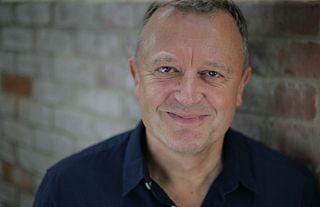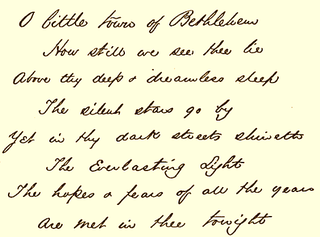
Philip Arnold Heseltine, known by the pseudonym Peter Warlock, was a British composer and music critic. The Warlock name, which reflects Heseltine's interest in occult practices, was used for all his published musical works. He is best known as a composer of songs and other vocal music; he also achieved notoriety in his lifetime through his unconventional and often scandalous lifestyle.

Sir John Milford Rutter is an English composer, conductor, editor, arranger, and record producer, mainly of choral music.

John Nicholas Maw was a British composer. Among his works are the operas The Rising of the Moon (1970) and Sophie's Choice (2002).

"We Three Kings", original title "Three Kings of Orient", also known as "We Three Kings of Orient Are" or "The Quest of the Magi", is a Christmas carol that was written by John Henry Hopkins Jr. in 1857. At the time of composing the carol, Hopkins served as the rector of Christ Episcopal Church in Williamsport, Pennsylvania, and he wrote the carol for a Christmas pageant in New York City. It was the first widely popular Christmas carol written in America.

The "Coventry Carol" is an English Christmas carol dating from the 16th century. The carol was traditionally performed in Coventry in England as part of a mystery play called The Pageant of the Shearmen and Tailors. The play depicts the Christmas story from chapter two in the Gospel of Matthew: the carol itself refers to the Massacre of the Innocents, in which Herod ordered all male infants under the age of two in Bethlehem to be killed, and takes the form of a lullaby sung by mothers of the doomed children.

Patrick Hawes is a British composer, conductor, organist and pianist.

Harold Edwin Darke was an English composer and organist. He is particularly known for his choral compositions, which are an established part of the repertoire of Anglican church music. Darke had a fifty-year association with the church of St Michael, Cornhill, in the City of London.
"I Saw Three Ships (Come Sailing In)" is an English Christmas carol, listed as number 700 in the Roud Folk Song Index. The earliest printed version of "I Saw Three Ships" is from the 17th century, possibly Derbyshire, and was also published by William Sandys in 1833. The song was probably traditionally known as "As I Sat On a Sunny Bank", and was particularly popular in Cornwall.

"In the Bleak Midwinter" is a poem by the English poet Christina Rossetti. It was published under the title "A Christmas Carol" in the January 1872 issue of Scribner's Monthly, and first collected in book form in Goblin Market, The Prince's Progress and Other Poems.

"O Little Town of Bethlehem" is a Christmas carol. Based on an 1868 text written by Phillips Brooks, the carol is popular on both sides of the Atlantic, but to different tunes: in the United States and Canada, to "St. Louis" by Brooks' collaborator, Lewis Redner; and in the United Kingdom and Ireland to "Forest Green", a tune collected by Ralph Vaughan Williams and first published in the 1906 English Hymnal.
Eric Harding Thiman was an English composer, conductor and organist. The surname is pronounced 'tea-man'. By 1939 he was considered one of the leading non-conformist organists in England. His choral and educational music is still performed today.

Katherine Kennicott Davis was an American composer, pianist, arranger, and teacher, whose most well-known composition is the Christmas song "Carol of the Drum," later known as "The Little Drummer Boy".

"In dulci jubilo" is a traditional Christmas carol. In its original setting, the carol is a macaronic text of German and Latin dating from the Middle Ages. Subsequent translations into English, such as J. M. Neale's arrangement "Good Christian Men, Rejoice" have increased its popularity, and Robert Pearsall's 1837 macaronic translation is a mainstay of the Christmas Nine Lessons and Carols repertoire. J. S. Bach's chorale prelude based on the tune is also a traditional postlude for Christmas services.
John Lawrence Kelsall was a British composer, conductor and lecturer.

"Ave Maria" is a setting of the Latin prayer Ave Maria, originally published in 1853 as "Méditation sur le Premier Prélude de Piano de S. Bach". The piece consists of a melody by the French Romantic composer Charles Gounod that he superimposed over an only very slightly changed version of Bach's Prelude No. 1 in C major, BWV 846, from Book I of his The Well-Tempered Clavier, 1722. The 1853 publication has French text, but it is the 1859 version with the Latin Ave Maria which became popular.

"The Three Kings", or "Three Kings From Persian Lands Afar", is a Christmas carol by the German composer Peter Cornelius. He set "Die Könige" for a vocal soloist, accompanied by Philip Nicolai's hymn "Wie schön leuchtet der Morgenstern", which he erroneously thought was an Epiphany hymn. In fact, it is an Advent hymn in which the morning star is an allegory for the arrival of Jesus, not the Star of Bethlehem. In Cornelius' original second setting, the accompaniment was played on a piano but the English organist Ivor Atkins later arranged the accompaniment for choir, with the choir singing the words of the original hymn. The German words have been translated into English by H.N. Bate. The carol describes the visit of the Biblical Magi to the Infant Jesus during the Nativity and is also used as an Epiphany anthem.
The Holy Boy is a short composition by the English composer John Ireland. Alongside his setting of the hymn "My Song Is Love Unknown", it is probably his best-known work. Originally for solo piano, Ireland arranged it for various other forces over nearly 30 years. A performance takes about 3 minutes.
Alexander Richard William L'Estrange is an English composer of choral music and music for television and an arranger for vocal ensembles. He is also a jazz musician, choral workshop leader, presenter of children's concerts and was a jazz examiner and trainer for ABRSM.
Gerald Wilfred Cockshott was an English composer, librettist, writer and teacher.

The Lamb is a choral work written in 1982 by British composer John Tavener (1944–2013). It is a setting of music to the William Blake poem "The Lamb" from Blake's collection of poems Songs of Innocence and of Experience (1789). It is one of Tavener's best known works. Written for unaccompanied SATB choir, the music is minimalistic and combines chromaticism with more conventional harmony.














